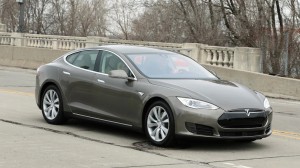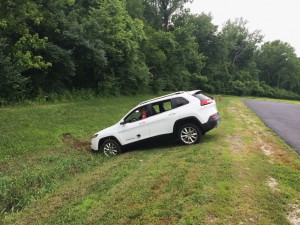When Tesla officially releases its new Pilot program, which will allow its Model S sedan to drive hands-free on limited access highways, owners won’t have to bring their cars to Tesla dealers to get the update. As it has with prior updates of the software running the Model S, the battery-carmaker will distribute the new software wirelessly.
Tesla isn’t alone. More and more manufacturers are developing ways to send out updates and add new features wirelessly.
The move could save them billions – and improve customer satisfaction in the process — by eliminating the need for owners to go to showrooms for repairs. But over-the-air technology also presents some potential risks as hackers turn their sights to the automobile.
“It is clear that OEM (original equipment manufacturers) cost savings from over-the-air software updates will be the most valuable part of this technology — by far,” said Egil Juliussen, a principal analyst of automotive technology at IHS Automotive, and a co-author of a new study on the technology.
Wireless updates are commonplace in the computer and smartphone world. It’s the method of choice for distributing everything from anti-virus updates to the latest operating system revisions. But the technology is just beginning to be accepted by automotive manufacturers.
When Lincoln experienced problems with the Sync infotainment system on the then-new MKZ system several years ago, it offered owners a thumb drive containing updated software. Less tech-savvy customers were told to bring their vehicles into the service shop, a costly process as Lincoln had to reimburse dealers for their time.
For customers, the use of wireless technology could eliminate the need for some service calls, especially at a time when the number of safety-related recalls has been rising. Some of those could be solved using over-the-air updates.
As vehicles become more and more high-tech, with digital safety and infotainment systems, electronic engine and transmission controllers and other systems that depend on software as much as mechanical devices, over-the-air updates offer tremendous promise. They make it possible to reach out quickly and easily to complete repairs or add new features.
Officials at BMW, for example, say they may wirelessly update the semi-autonomous driving system on the all-new 750i sedan in the near future to expand its capabilities.
General Motors’ OnStar division is set to launch a new feature next year that will monitor a vehicle’s functions and issue an alert if, for example, the battery or water pump are starting to fail. The onboard software is linked to a cloud-based database that improves the accuracy of the system. Eventually, OnStar will be able to automatically schedule service for mechanical problems or download software to fix digital issues.
The IHS study says navigation and infotainment systems, Telematics controls, and critical electronic control units for things like engines and transmission all could be updated with the over-the-air technology.
Savings from the over-the-air software update events will grow from $2.7 billion in 2015, to more than $35 billion in 2022 as the complexity of the over-the-air upgrades continues to grow.
There will likely be a number of different paths manufacturers will have into the vehicle. These range from satellite delivery to the 4G LTE hot spots. Chevrolet, for example, plans to install 4G on virtually all of its models starting in the 2016 model-year.
While automakers are taking the lead in this new field, outside players are looking at opportunities. Last week, Verizon officially began marketing the Hum system it announced at the Detroit Auto Show last January. Aimed at older vehicles without factory systems like OnStar, it can provide a motorist with diagnostic information, connect them with service technicians and provide other emergency services. Verizon hasn’t said if it can or will add the ability to update software on older vehicles, as well.
There is at least one potential downside. Automakers acknowledge the addition of telematics-based systems to the vehicle could increase the threat of hacking. The industry long ignored the problem, believing that without an easy way to access vehicle controls from outside the vehicle hackers would have little interest in the automotive world.
But with a rapid increase in wireless channels into the vehicle – everything from the wireless systems used to monitor tire pressure to new onboard 4G LTE systems – that is no longer the case.
Hackers are looking to exploit “potentially every channel on the vehicle that provides access to services or maintenance,” warned Saar Dickman, CEO of TowerSec, an Israeli cybersecurity company working with a number of automakers.
While there have been no major cyber attacks – yet – several researchers showed the potential depth of the problem recently. That included a project that allowed two hackers to take control of a Jeep Cherokee, sending it spinning into a ditch.
The push to permit wireless updates, experts warn, will only focus more attention on the need to develop better mobile cyber security.
(Joe Szczesny contributed to this report.)




Depending on the year and brand of vehicle accessing trouble codes will a degree of access with regard to manufacturers proprietary software. As a prototype technician and line technician for Ford and Chrysler and Componentry in Heavy Trucks and military Vehicles connectivity is easier going forward than backwards. Connecting through the obd port gets you what is required for emmission diagnoistics nothing else, unless you have the manufacturers diagnostics hardware and updated software. Their software,not a hacked chinese source. Pre obd veicle have generational evolutions of engine and transmission operation from mechanical to electronic operation. Most programing is accomplihed by physically replacing the pcm. Programing was done at the manufacturers level. They weren’t worried about hacking , they were just glad it worked. Diagnoise was primative, component fault testing. Emmission/ check engine light componentry devices are covered by federally mandated laws and are required to be fixed by the manufacturer by the dealer. Why pay more for a third party? Full disclosure. I’ve got over 40 years in the automotive business and 4 year marketing and dealership operations degree with 15 years as a general manager and every other title and position.
There is a huge responsibility to use secure update communication and to have a program that confirms the update has been 100% properly installed and not corrupted as was the software installation that killed several pilots and test engineers recently in Europe. Defective software code, insufficient security or botched updates should be met with criminal charges and massive fines because there is no reason for these potentially deadly and preventable errors.
Worrying about hacking is about the same about y2k.
The really geeky though that the world was going stop/ end because of a inability of software to go beyond 2000. Some people world is way too small. Listen, I can here the geeks at the doors now seething with hacking threats. Now for the fun.
Actually not many people with a clue figured the world would end at the change of the century. The concern was old computer installations that had no means to know there was a change of the century and thus their operation was unpredictable. As it turned out even several years after the change there were computerized systems malfunctioning because they were not replace or updated to deal with the change of the century issues. No panic, just real world problems that actually materialized. These PC issues had nothing to do with hacking or evil people however so your analogy is pointless.
Being so naïve as to think hacking of cars is not happening everyday illustrates your lack of technical expertise on the subject. For several years criminals have been unlocking car doors and stealing personal items and then closing the doors and leaving without a trace because they can circumvent the OEM digital alarm systems. In addition to cars being hacked daily, military and government servers are being hacked as well as banks and large industry.
Next week the U.S. will announce sanctions against China for hacking U.S. government and military servers. At the recent Black Hat convention they illustrated taking control of a Jeep via the infotainment system. The following week some geeks took control of the Tesla S model even though Tesla claimed how superior their security systems were. As usual, Elon Musk was wrong.
Anyone who isn’t concerned about the known security issues that are getting worse by the week, is in deep, deep denial. AVs will be so much fun for the black hats that they can’t wait to start screwing with them. Denial has never changed reality. Those who bury their head in the sand usually get kicked in the balls. Then they complain that no one warned them of the danger of living in denial.
Being unable to handle the truth is by definition, denial. As numerous people have explained to you in numerous threads your beliefs DWH are not supported by reality. Hating on people because your beliefs are incorrect doesn’t change anything.